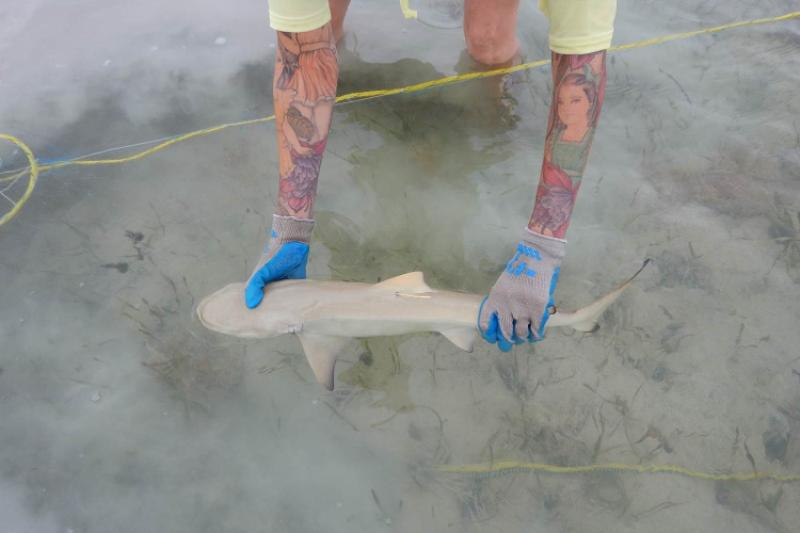MYTH: You Have to Scuba Dive to Do Shark Research
Scuba diving for shark research is one of many effective research tools that allows scientists to collect data on sharks. It is especially beneficial when researching large sharks, such as a whale shark, which would be too difficult to catch. Scuba is also an effective research method for observing sharks in their natural habitat with little to no human interaction. While Scuba is a valuable tool, there are dozens of other ways to do shark research that do not require Scuba diving or even access to the ocean.
Hands-on shark research is often conducted using fishing vessels or fishing from beaches. Sharks are caught using fishing gear and brought alongside the vessel. Scientists then take measurements, samples, and photos and attach tracking devices and informational tags to collect information on the shark and its ocean environment. NOAA Fisheries even organizes and runs some of these shark surveys to gather important information to keep the sharks we manage sustainable
Shark research can be conducted at aquariums and laboratories, or even in libraries. There are many universities and research institutes in landlocked states that offer degree and research programs at satellite marine labs or conduct field research abroad.
Within NOAA Fisheries, there are people from diverse career backgrounds working to study and sustainably manage sharks. NOAA Fisheries employs biologists, fishery managers, data scientists, economists, environmental scientists, and social scientists—to name a few. Each of these positions is key to assessing shark fisheries, conducting stock assessments, collecting and analyzing data, and keeping shark fisheries sustainable.
MYTH: Shark Attacks Are on the Rise
Due to media exposure and the viral nature of reporting shark attacks, there’s a misperception that sharks are bloodthirsty predators that hunt humans. In 2022, there were fewer unprovoked shark bites compared to the 5-year average between 2017–2021. The University of Florida’s International Shark Attack File is a scientifically documented, comprehensive database of all known shark attacks. They recorded a worldwide total of 57 unprovoked shark bites in 2022, 41 of which were in the United States and 1 that was fatal. In comparison, between 2017–2021, there was a global average of 70 unprovoked shark bites annually.
So why does it seem like shark attacks on beach goers are becoming increasingly common?
- Cell phones and social media - Technology makes it easier than ever to share shark sightings or encounters worldwide in near real time. Dramatic images or video can quickly go viral and attract the attention of the internet, print, television, and other media outlets. This feeds the perception that shark attacks are happening more frequently.
- Dramatic numbers – Because the number of annual shark attacks is small, any increase or decrease in the number of bites can make trends seem dramatic.
- Sensational language – Human-shark interactions are often reported as attacks even if the person was not bitten. This language is misleading and can lead to negative perceptions of sharks. Shark scientists have proposed categorizing human-shark interactions to more accurately portray what occurred and prevent spreading misinformation.
- More sharks – As a result of fishing regulations, several shark stocks are rebuilt or are rebuilding. These larger populations of Atlantic sharks hunt prey in nearshore waters, sometimes increasing the risk of human-shark encounters. Prey populations have also been rebuilt or are in the process of rebuilding, and water quality is improving, which could contribute to the increase in shark presence nearshore.
- More people – According to the U.S. Census Bureau, approximately 12 percent of the U.S. population now lives in an Atlantic coastal county. Beach attendance has also been steadily increasing since 1994. More people near the beach and in the water means increased opportunities for human-shark interactions.
While human-shark interactions might increase, it is extremely unlikely that Atlantic beach goers will be bitten by a shark.
NOAA Fisheries shark scientist, John Carlson, explains why sharks attack people and how common are shark attacks.
MYTH: NOAA Fisheries Is Not Involved in Global Shark Conservation
The United States is a global leader in shark conservation and sustainable fisheries management. NOAA Fisheries works with our partners to prevent overfishing and rebuild U.S. stocks. Did you know that we also work closely with the U.S. Department of State and other federal partners to promote global shark conservation and management?
Because many sharks are highly migratory and cross international boundaries, the cooperation of multiple countries is necessary to manage and conserve sharks across their ranges.
NOAA Fisheries’ International Engagement
The United States participates as a member or observer to several regional fishery management organizations. RFMOs are treaty-based bodies whose objective is to ensure the sustainable conservation and management of shared fish stocks and other living marine resources through international cooperation.
International Commission for the Conservation of Atlantic Tunas
The United States is a member of a regional fishery management organization in the Atlantic Ocean called the International Commission for the Conservation of Atlantic Tunas. ICCAT oversees the conservation and management of a variety of Atlantic marine species, including tunas, swordfish, marlin, and sharks, and adopts measures to minimize bycatch of turtles and seabirds associated with these fisheries. In 2022, ICCAT adopted new management measures to rebuild the overfished North Atlantic shortfin mako shark.
Inter-American Tropical Tuna Commission and the Western and Central Pacific Fisheries Commission
The United States also advocates for shark conservation management measures internationally at other regional fishery management organizations, including Inter-American Tropical Tuna Commission and the Western and Central Pacific Fisheries Commission . The IATTC is responsible for the long-term conservation and sustainable management of tuna and tuna-like species and other species of fish in the Eastern Pacific Ocean. The WCPFC seeks to address problems in the management of high seas fisheries resulting from unregulated-fishing, over-capitalization, and excessive fleet capacity. We participate in the Western Central Atlantic Fishery Commission to promote the effective conservation, management, and development of the living marine resources in the wider Caribbean.
Convention on International Trade in Endangered Species
The Convention on International Trade in Endangered Species is an international agreement designed to ensure that international trade in animals and plants does not threaten their survival in the wild. Although the Endangered Species Act designates the U.S. Fish and Wildlife Service to carry out CITES provisions, NOAA Fisheries supports them by providing guidance and scientific expertise on marine issues. We are also responsible for managing and protecting many marine species that are listed under CITES, including sharks. Convention on Migratory Species and the Memorandum of Understanding on the Conservation of Migratory Sharks. NOAA Fisheries contributes to the Convention on Migratory Species and is a signatory to its Memorandum of Understanding on the Conservation of Migratory Sharks, which helps facilitate international coordination on the assessment and management of sharks that range across multiple nations.
International Support Activities
The United States works internationally to promote the "fins naturally attached" policy overseas and provide technical support for other countries’ shark conservation efforts. Support activities include shark identification training and data collection workshops. We collaborate with other countries on research aimed at achieving science-based management measures and conservation of sharks in our global ocean.
International Research Support
- NOAA Fisheries invests millions of dollars in shark research-both domestically and internationally-to support sustainable shark fisheries conservation and management.
- Our scientists routinely collaborate on shark research with international partners, supporting global conservation efforts.
Multiple NOAA Fisheries grant programs, such as the Cooperative Research Program, the Bycatch Reduction Engineering Program, and others include priorities for supporting international research.
MYTH: Shark Populations Are Exploding
This myth is being widely spread due to increased shark "depredation". The word depredation refers to when fishermen reel in their catch only to find that the fish has been partially or totally eaten by a shark. While the problem of sharks feeding on fishery catches is not new, reports of these events are on the rise. The higher frequency of these events makes some believe that shark populations are suddenly exploding. It is also leading fishermen and fishing guides to develop negative attitudes toward sharks.
Research suggests the increase in shark depredation is likely due to several factors, including:
- Rebuilding of certain shark populations and increasing abundance of sustainably managed shark stocks.
- Increasing released and discarded catch of fish due to more restrictive regulations.
- Shifting distributions of shark species due to climate change.
- Developing learned behaviors. Sharks might be behaving differently as they learn to associate the sounds of fishing boats with easy meals.
The increase in shark depredation doesn’t mean that all shark populations have recovered or are out of control. Conservation efforts and implementation of shark fishing regulations have led to the rebuilding of multiple shark stocks, including those commonly blamed for depredation, but some are still far from being fully rebuilt.
There is growing interest from the public and Congress in the implications and potential solutions to shark depredation. In 2022, NOAA Fisheries completed a Report to Congress on the interactions between bottlenose dolphins and sharks and fisheries in the Gulf of Mexico and South Atlantic. The report quantifies the degree to which dolphins and sharks interfere with commercial, charter, and recreational fishing and recommends non-lethal methods to deter dolphins and sharks.
NOAA Fisheries has funded several cooperative research studies in the Atlantic and Gulf of Mexico aimed at characterizing and reducing the extent of shark depredation in the region. We’re collecting genetic data to identify which shark species are mostly commonly responsible for depredation events and surveying fishermen about their depredation experiences. Ultimately, we hope to identify best practices that will help fishermen to avoid unwanted interactions with sharks.
MYTH: Shark Populations Are Disappearing
There are several misperceptions about the status of shark populations in the United States and around the world. One that is often mentioned is that “all sharks are in danger of extinction.” That is not the case in the United States. Many U.S. Atlantic shark stocks are healthy, and those that are not are rebuilding. Understanding the status of U.S. shark populations is critical to implementing effective management measures needed to balance conservation with human interactions. However, this process is complex and requires the cooperation of multiple domestic and international organizations.
Domestic vs. Global Shark Status
Understanding the status of any species that exists in both U.S. and international waters is difficult not only due to misunderstandings that surround how the populations are assessed but also the language we use to describe their status.
Shark stock assessments are conducted both at the domestic and international level, depending on the range of the species. Most domestic U.S. Atlantic shark stock assessments are conducted through the SouthEast Data, Assessment, and Review, or SEDAR, process. Atlantic sharks that have ranges extending beyond U.S. waters are assessed through the International Commission for the Conservation of Atlantic Tunas' (ICCAT) Standing Committee on Research and Statistics.
Organizations like the International Union for the Conservation of Nature report on species statuses, but they look at shark stocks globally. They use different criteria for listing species as threatened or endangered than we do at NOAA Fisheries. One example of the regional versus global difference is the blacktip shark, which is fully rebuilt in the U.S. Atlantic but still categorized as near threatened by IUCN. Although NOAA Fisheries scientists participate in the species assessments for the IUCN Red List, a comprehensive list on the extinction risk of animals, fungi, and plants, we base our management actions on U.S. laws and not IUCN designations.
Stock Assessments and Stock Status
Stock assessments are the scientific foundation of successful and sustainable fishery management. Through measuring the impact of fishing, stock assessments can help prevent overfishing, protect the marine ecosystem, and rebuild overfished stocks.
Since 2007, SEDAR and ICCAT have assessed 17 shark stocks. Eight stocks are not experiencing overfishing, including the five shark species that account for the majority of U.S. shark harvest. The six stocks that are overfished are in rebuilding plans with strict catch limits.






